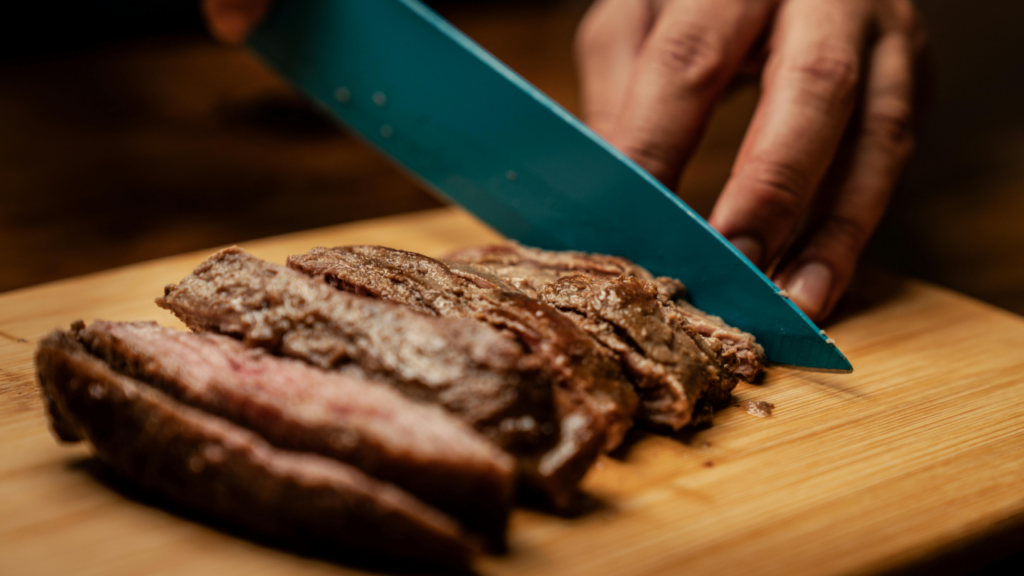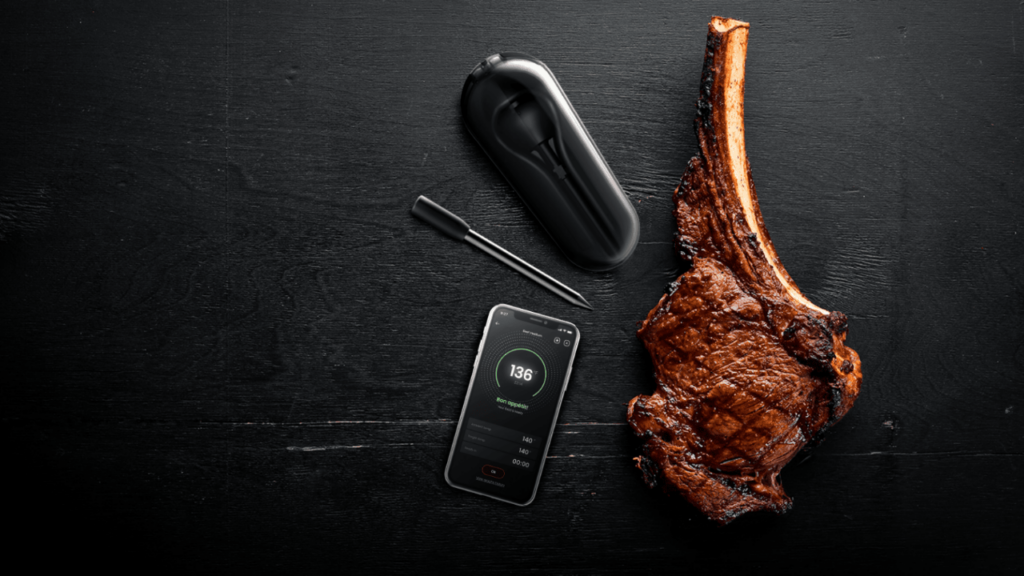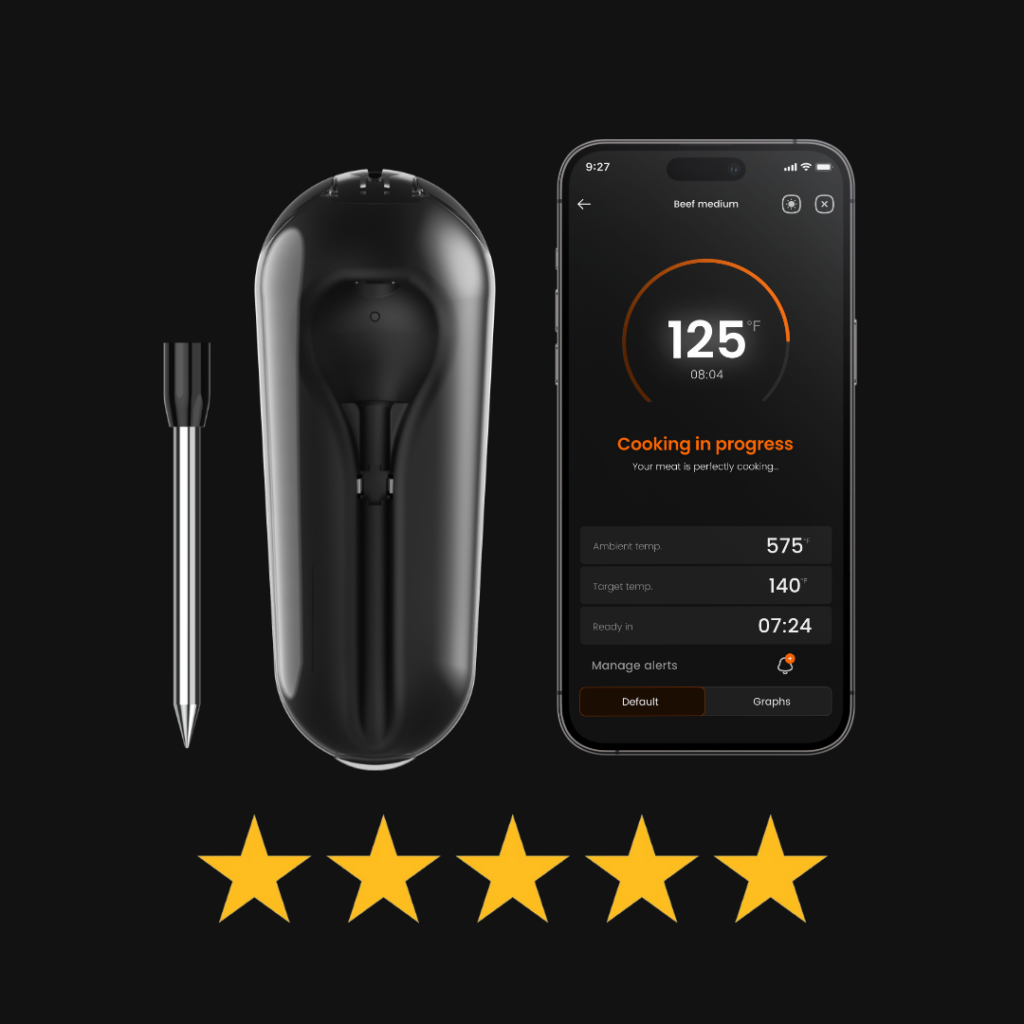When it comes to grilling steak, everyone seems to have their secret recipe or method that they swear by. From the high-heat sear to the low-and-slow approach, methods vary widely. However, one unconventional technique has been making waves among culinary enthusiasts: flipping your steak every 30 seconds. This method challenges long-standing grilling traditions and promises a steak that’s evenly cooked, juicier, and packed with flavor. In this article, we’ll delve into why this technique might just be the game-changer in your cooking repertoire, as we demonstrate how using our wireless meat thermometer the Meat°it 3 plus this technique can produce the juiciest and most flavorful steak.
The Traditional Method of Cooking Steak
Traditionally, steaks are cooked by placing them on a hot grill or pan and flipping them once, halfway through the cooking time. The belief is that this method allows one side to sear and seal in the juices before cooking the other side. However, this practice is based on intuition rather than science, leading to common misconceptions, such as the need to sear steaks on high heat to lock in juices, which have been debunked by food scientists.
The Science Behind Flipping Every 30 Seconds
Flipping a steak every 30 seconds during grilling challenges traditional cooking norms but is rooted in solid food science, particularly concerning even heat distribution and the Maillard reaction. This frequent flipping method ensures that heat is more evenly distributed across the steak, reducing the temperature gradient, and preventing overcooked edges and undercooked centers. It leads to a uniform cooking process, contrasting sharply with the unevenness that often results from the traditional method of flipping the steak only once.
The Maillard reaction, responsible for the browning and flavoring of the steak, is also optimized by this method. Regular flipping prevents any part of the steak from overheating and promotes a faster, more uniform reaction, resulting in a consistently flavorful and well-seared crust. This technique not only enhances the steak’s flavor but also contributes to a juicier, more tender final product, as it prevents excessive moisture loss typically associated with one-sided, prolonged cooking. Check out our article on “From Rare to Well-Done: Understanding Meat Doneness Levels” to learn more about it.
Adopting the technique of flipping a steak every 30 seconds might seem tedious but offers a scientifically sound approach to achieving the perfect steak. It represents a shift towards more informed, precision-based cooking, encouraging both professional chefs and home cooks to experiment and embrace new methods for better culinary results. This approach not only demystifies the art of cooking the perfect steak but also showcases the practical benefits of understanding and applying food science in everyday cooking.
Benefits of Flipping Every 30 Seconds
- Uniform Cooking and Even Heat Distribution:
Flipping your steak every 30 seconds is not just a culinary trick; it’s a method grounded in the science of heat transfer. This frequent flipping ensures that heat penetrates the meat more evenly, significantly reducing the temperature gradient within the steak.
The result? A steak that is cooked uniformly throughout, eliminating the all-too-common problem of a piece of meat that’s charred on the outside while still raw or undercooked in the center. This method ensures that every bite is cooked to the same degree of doneness, providing a consistently enjoyable eating experience.
- Improved Texture and Juiciness:
One of the most significant advantages of this method is the impact on the steak’s texture and juiciness. Traditional methods that involve cooking the steak on one side for an extended period before flipping can lead to moisture loss, resulting in a drier, tougher steak. By flipping the steak every 30 seconds, you minimize its exposure to extreme heat, which helps to retain its natural juices. The result is a steak that is not only tender but also full of flavor, as these juices are where much of the meat’s flavor resides.
- Enhanced Flavor and Perfect Sear:
The Maillard reaction, a chemical process that gives browned food its distinctive flavor, is optimized by frequent turning. This reaction requires high temperatures to occur, but if the steak is left for too long on one side, it can lead to burning and a bitter flavor. By flipping the steak every 30 seconds, each side gets just enough heat to promote this reaction without burning, leading to a richly flavored and perfectly seared exterior. The constant movement ensures that the entire surface of the steak comes into direct contact with the heat source, creating a beautifully caramelized crust without overcooking the interior.
- Reduction in Cooking Time:
Interestingly, this method can also reduce the overall cooking time. When both sides of the steak are exposed to heat more frequently, the steak reaches the desired internal temperature faster. This is particularly beneficial for those who prefer their steak medium-rare to medium, as it reduces the window of time in which the steak can go from perfectly cooked to overdone. Additionally, this faster cooking time can be a boon during busy meal preparations, allowing you to focus on accompanying dishes while still achieving an expertly cooked steak.
How to Properly Flip Your Steak
Required Tools and Preparation:
- Wireless Meat Thermometer The Meat°it 3: Essential for monitoring the internal temperature.
- Grill or Cast-Iron Skillet: Choose your cooking surface based on preference; both should be able to maintain a high, consistent heat.
- Tongs: These will allow you to flip the steak safely and quickly without piercing the meat, which could cause juices to escape.
- Timer or Stopwatch: Crucial for keeping track of the 30-second intervals.
- Steak of Choice: Ensure your steak is at room temperature before cooking to promote even cooking throughout.
- Seasoning: Salt and pepper or your preferred steak seasoning should be applied before cooking.
You can learn more about our Meat°it 3 and the science behind it in this article “The Science Behind our Wireless Meat Thermometer”.
Detailed Instructions for the Flipping Technique:
- Preheat: Heat your grill or skillet to a high temperature. For grills, aim for 450-500°F (232-260°C); for skillets, they should be smoking slightly.
- Season the Steak: Apply your seasoning evenly to both sides of the steak.
- Initial Placement: Place your steak on the grill or skillet. Start your timer as soon as the steak hits the surface.
- The Flip: After 30 seconds, use tongs to flip the steak to the other side. Continue to flip the steak every 30 seconds. This frequent flipping ensures even cooking and heat distribution.
- Monitor Temperature: Insert the wireless meat thermometer into the thickest part of the steak. Monitor the temperature without lifting the lid too often, to maintain a consistent cooking environment.
Temperature and Timing Tips for Perfect Doneness
- Rare: Aim for an internal temperature of 120-130°F (49-54°C). This usually takes about 2-3 minutes total cooking time, depending on the steak’s thickness.
- Medium-Rare: Target 130-135°F (54-57°C). Typically, this level of doneness requires 4-5 minutes of total cooking time.
- Medium: Look for a temperature of 135-145°F (57-63°C). Generally, this will take around 5-7 minutes total.
- Medium-Well to Well-Done: These levels are less recommended for this cooking method due to the risk of drying out the meat. However, if preferred, aim for 145-160°F (63-71°C) for medium-well and above 160°F (71°C) for well-done, extending the flipping intervals as needed.
Additional Tips:
Connect the Thermometer: Ensure your wireless meat thermometer The Meat°it 3 is connected before inserting it into the steak to get the most accurate reading.
Rest the Meat: Allow your steak to rest for at least 5 minutes after cooking. This lets the juices redistribute throughout the meat, ensuring a juicier steak.
Adjust for Thickness: Keep in mind that thicker steaks will require longer cooking times, and flipping should be adjusted accordingly.
Use High Heat: High heat is crucial for this method to ensure a good sear and proper execution of the Maillard reaction.

Addressing Common Concerns and Myths
Many people worry that frequent flipping will cause steaks to lose their juices or fail to develop a good sear. However, scientific testing has shown that these concerns are unfounded. Steaks flipped frequently retain as much juice, if not more, than those flipped infrequently and still develop a desirable, caramelized crust.
Comparison with Other Cooking Methods
- Traditional Grilling (Single Flip Method):
Merits: This conventional approach, where the steak is flipped only once during cooking, is favored for its simplicity and the minimal attention it requires. It’s a method steeped in tradition, often associated with classic barbecue and grilling culture.
Drawbacks: However, the single flip method can lead to uneven cooking, particularly with thicker cuts. The steak may end up overcooked on the outside while remaining undercooked in the center. It requires a lot of guesswork regarding timing and temperature, often leading to inconsistent results.
- Oven Finishing:
Merits: Starting the steak on the stove and finishing it in the oven is a popular method for achieving a more evenly cooked interior, especially for thicker cuts. This method allows for a controlled environment for the steak to cook through more evenly after being seared on the stovetop.
Drawbacks: While oven finishing can provide a more uniform internal temperature, it still lacks precise control over the doneness of the steak. There’s also the additional step of transferring the steak from stovetop to oven, which can be inconvenient and time-consuming.
- Sous-Vide Cooking:
Merits: Sous-vide is renowned for its precision in temperature control, allowing for a steak to be cooked to the exact desired internal temperature throughout. This method eliminates much of the guesswork associated with traditional cooking methods and ensures a consistently cooked steak from edge to edge.
Drawbacks: The main disadvantage of sous-vide is the lack of a sear, which is crucial for flavor and texture. A post-sous-vide sear is often required to achieve the characteristic crust, adding an extra step to the cooking process. Additionally, sous-vide cooking requires special equipment and considerably more time than traditional methods.
- Flipping Every 30 Seconds:
Advantages: Flipping a steak every 30 seconds combines the best aspects of traditional and modern cooking techniques. It offers a method that leads to even cooking and a perfect sear without requiring the additional equipment or time commitment of sous-vide. This technique, best used with a wireless meat thermometer such as the Meat°it 3 reduces the temperature gradient inside the steak, ensuring that the interior cooks evenly while still achieving the Maillard reaction that gives the steak its flavor.
Balance of Ease, Control, and Quality: This method strikes an excellent balance between ease of cooking, control over the doneness, and the quality of the final product. It is less time-consuming than sous-vide and offers more precision than the single flip method or oven finishing. While it requires more attention during cooking than traditional methods, frequent flipping is a simple process that yields superior results.

Conclusion
Flipping your steak every 30 seconds might initially sound like a bit of a chore, but the payoff is well worth the effort. This method isn’t just a fancy culinary trick; it’s a practical approach to grilling that ensures your steak comes off the heat perfectly cooked, tender, and packed with flavor. We understand the importance of getting that steak just right, and this technique offers a reliable path to achieving that goal every single time. Also, it is safe to say that the duration can differ according to the size and thickness of the steak, as it may take longer or shorter, and at best thirty seconds.
We encourage you to give this method a shot during your next barbecue. The difference in texture and taste is noticeable, and it’s a game-changer for anyone serious about their steak. Pairing this method with a reliable wireless meat thermometer like our Meat°it 3 can take your grilling accuracy to the next level, ensuring that your steak is never under or overdone, but just right. For more, you can check out what Tasting Tables has got to say about making dinner parties easier using our wirelesss digital thermometer. Bon appétit!

